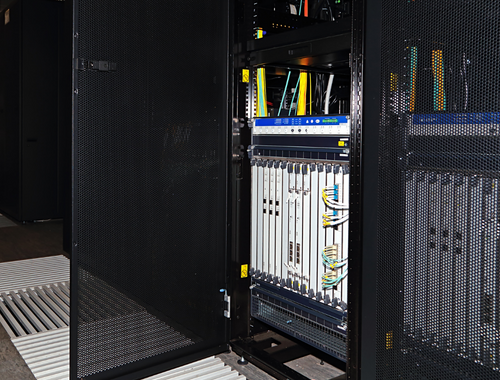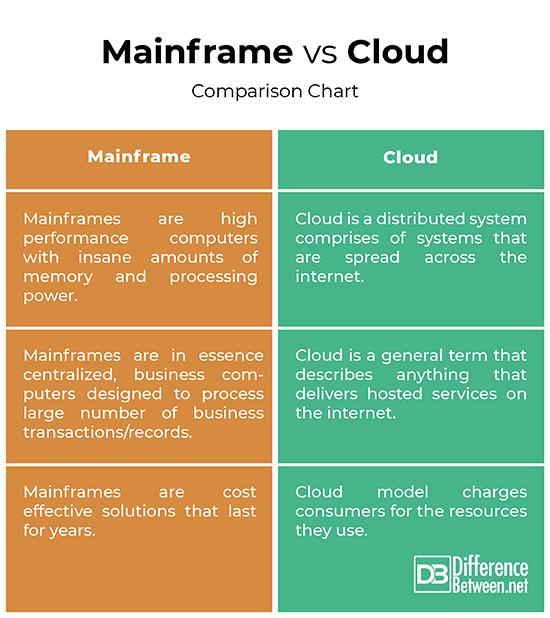Difference Between Mainframe and Cloud
For enterprise IT infrastructure, a mainframe is probably the most cost effective alternative to modern cloud computing for one major reason – scalability. It’s their ability to dynamically scale resources and power that gives mainframe a strategic edge over cloud. It’s true that cloud computing has revolutionized IT and business by making computing available as a utility over the internet. The evolution of the Internet into a cloud computing platform is hardly a mystery. But the question is what the differences between the conventional mainframe computing and today’s cloud are computing.

Mainframe
Mainframes are data servers known generally for their large size, processing power and amount of storage. You can think of mainframe as a really big computer. Well, all computers were big In the 1970s and 1980s. Back then, the term mainframe was used to refer to a number of different computer systems. These are high performance computers with insane amounts of memory and processing power. They are capable of processing trillions of web transactions every day with the highest levels of security. Typically, mainframe almost always refers to IBM’s zSeries computers. Mainframes no longer rule the data centers, but they still run hundreds of thousands of enterprise applications. This is not going to change any time soon.

Cloud
Cloud, in all its forms, has revolutionized the computing landscape. It changed the way you deploy technology and how you think about the economics of computing. But what exactly is this cloud? In simple layman terms, cloud is the internet – it’s all the things you can access remotely over the internet. You can think of cloud computing as the foundation for the industrialization of computing. It is a vast network of remote servers hosted on the internet for storing and accessing data on an on-demand basis. It is on-demand delivery of IT resources such as the servers, storage, databases, software, hardware, etc. over the internet. A cloud environment needs a built-in service that bills customers. And to calculate that bill, usage has to be monitored and tracked.
Difference between Mainframe and Cloud
Architecture
– Mainframes are really large computer systems that use special CPUs many of which are physically very large and processors called systems assistance processors that do nothing but move data around as quickly as possible. Cloud, on the other hand, is a distributed system architecture comprises of systems that are spread across the internet. Cloud computing is a set of approaches that can help organizations add and subtract resources in almost real time quickly and effectively.
Computing
– Mainframes are high performance computers with insane amounts of memory and processing power and are designed for ultra high volume and processor intensive computing. These are centralized business computers that live inside really big cabinets. Cloud is internet, rather than private leased lines. Cloud is a general term that describes anything that delivers hosted services on the internet. Cloud transforms computing itself into a utility that can be accessed over the internet.
Scalability
– Mainframes and their operating systems are insanely expensive; in fact a single mainframe can cost hundreds of thousands if not millions of dollars. The biggest draw of cloud computing is the ability for end users to rapidly provision the resources they need and a pricing model that charges consumers for only the resources they actually are using. The concentration of massive clusters computing resources within cloud opens up possibilities for large scale data analysis at an unprecedented scale.
Mainframe vs. Cloud: Comparison Chart

Summary
In a nutshell, cloud is not exactly a replacement for the good old behemoth computers called mainframes. Cloud is just a more cost-effective and innovative way of achieving the same basic functionality that mainframes were designed for decades ago. But cloud computing is more than a service sitting in some remote data center. Cloud makes it easy for organizations or companies to see their computing systems as a pool of resources rather than a set of independent environments that each has to be managed. The best thing about cloud is that you can easily get cloud services anywhere you want and anytime you want.
Is mainframe a cloud?
Mainframe offers all the components and the hardware required to run a private cloud environment. But a mainframe is not cloud. Simply put, Cloud is the internet.
Why is mainframe better than cloud?
Mainframes are still used by large companies to perform large-scale processing of data including business transactions and/or records.
Can mainframe be moved to cloud?
There’s plenty of room for mainframes in the modern cloud computing environment. Companies are also looking to move mainframe workloads to robust cloud platforms.
What is future of mainframe?
There is definitely an undeniable role for mainframes in the future for large organizations. But many tech gurus believe in the advent of the cloud computing, mainframes may fade away.
Which cloud is best for mainframe?
There are a plethora of hybrid cloud service providers that can guarantee seamless on-boarding to the cloud platform. Public cloud platforms like Microsoft Azure are great alternatives to mainframes.
Is IBM a mainframe?
ISM is a technology giant that makes mainframes. In fact, IBM is a global leader in mainframe technology for over five decades.
Can I switch from mainframe to AWS?
AWS Mainframe Modernization is a unique platform that allows you to seamlessly migrate your mainframe workloads to AWS managed runtime environments.
Does Google use mainframes?
No. Google does not use mainframes.
Why is mainframe still in use?
May be mainframes no longer rule the data center, but they are still used by some of the world’s largest corporations. In fact, they play a crucial role in the daily operations for business, finance, and administrative systems.
- Difference Between Caucus and Primary - June 18, 2024
- Difference Between PPO and POS - May 30, 2024
- Difference Between RFID and NFC - May 28, 2024
Search DifferenceBetween.net :
Leave a Response
References :
[0]Hurwitz, Judith S., et al. Cloud Computing For Dummies. New Jersey, United States: John Wiley & Sons, 2010. Print
[1]Chee, Brian J.S. and Curtis Franklin Jr. Cloud Computing: Technologies and Strategies of the Ubiquitous Data Center. Florida, United States: CRC Press, 2010. Print
[2]Shroff, Gautam. Enterprise Cloud Computing: Technology, Architecture, Applications. Cambridge, United Kingdom: Cambridge University Press, 2010. Print
